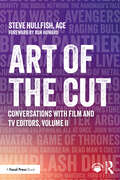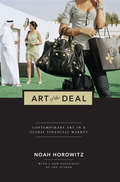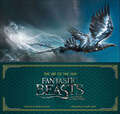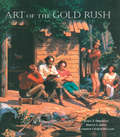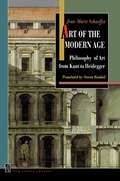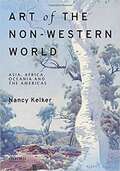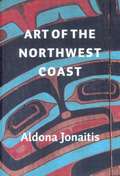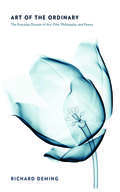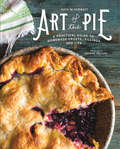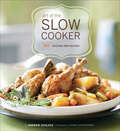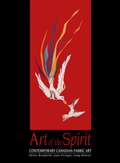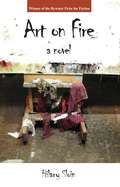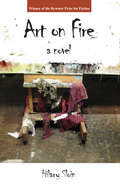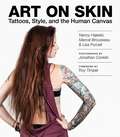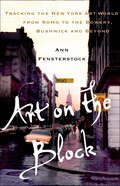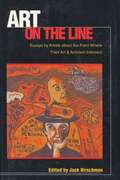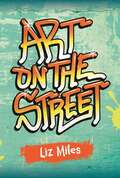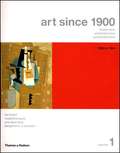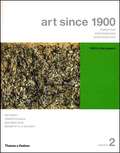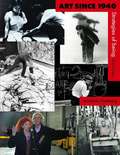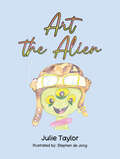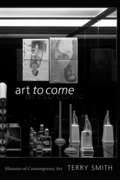- Table View
- List View
Art of the Cut: Conversations with Film and TV Editors, Volume II
by Steve HullfishThis is the second volume of the widely acclaimed Art of the Cut book published in 2017. This follow-up text expands on its predecessor with wisdom from more than 360 interviews with the world’s best editors (including nearly every Oscar winner from the last 30 years).Because editing is a highly subjective art form, and one that is critical to the success of motion picture storytelling, it requires side-by-side comparisons of the many techniques and solutions used by a wide range of editors from around the world. That is why this book compares and contrasts methodologies from a wide array of diverse voices and organizes that information so that it is easily digested and understood.There is no one way to approach editorial problems, so this book allows readers to see multiple solutions from multiple editors. The interviews contained within are carefully curated into topics that are most important to film editors and those who aspire to become film editors. The questions asked, and the organization of the book, are not merely an academic or theoretical view of the art of editing but rather the practical advice and methodologies of actual working film and TV editors, bringing benefits to both students and professional readers.The book is supplemented by a collection of downloadable online exclusive chapters, which cover additional topics ranging from Choosing the Project to VFX. In addition to the supplementary chapters, access to the full-color, full-resolution images printed in the book—and other exclusive images—is included.
Art of the Deal: Contemporary Art in a Global Financial Market
by Noah HorowitzArt today is defined by its relationship to money as never before. Prices have been driven to unprecedented heights, conventional boundaries within the art world have collapsed, and artists think ever more strategically about how to advance their careers. Art is no longer simply made, but packaged, sold, and branded. In Art of the Deal, Noah Horowitz exposes the inner workings of the contemporary art market, explaining how this unique economy came to be, how it works, and where it's headed.In a new postscript, Horowitz reflects on the evolution of the trade since the book's original release in 2011, shining light on the market's continued ascent as well as its most urgent challenges.
Art of the Film: Fantastic Beasts and Where to Find Them
by Dermot PowerAn in-depth, fully illustrated look at the art and artists behind the awe-inspiring world of J.K. Rowling’s Fantastic Beasts and Where to Find Them.Led by Academy Award®–winning production designer Stuart Craig, a number of art departments were responsible for creating the unforgettable characters, locations and beasts from the 2016 fantasy film that expanded on the Wizarding World of Harry Potter. In this beautifully illustrated volume, Dermot Power—a concept artist on the film—takes you on a magical journey through a design process every bit as wonderful as that encountered by Newt Scamander: from the earliest gatherings of the artists, designers and filmmakers to the magical time of the film’s production.Bursting with hundreds of production paintings, concept sketches, storyboards, blueprints and matte paintings, and filled with unique insights about the filmmaking journey from Stuart Craig and the artists themselves, this superb book presents a visual feast for readers, and will welcome fans of Harry Potter films into the world of Fantastic Beasts and Where to Find Them.
Art of the Gold Rush: (Published in association with the Oakland Museum of California and the Crocker Art Museum, Sacramento)
by Harvey L. Jones Janice T. Driesbach Katherine Church HollandThe California Gold Rush captured the get-rich dreams of people around the world more completely than almost any event in American history. This catalog, published in celebration of the sesquicentennial of the 1848 discovery of gold at Sutter's Mill, shows the vitality of the arts in the Golden State during the latter nineteenth century and documents the dramatic impact of the Gold Rush on the American imagination. Among the throngs of gold-seekers in California were artists, many self-taught, others formally trained, and their arrival produced an outpouring of artistic works that provide insights into Gold Rush events, personages, and attitudes. The best-known painting of the Gold Rush era, C.C. Nahl's Sunday Morning in the Mines (1872), was created nearly two decades after gold fever had subsided. By then the Gold Rush's mythic qualities were well established, and new allegories--particularly the American belief in the rewards of hard work and enterprise--can be seen on Nahl's canvas. Other works added to the image of California as a destination for ambitious dreamers, an image that prevails to this day. In bringing together a range of art and archival material such as artists' diaries and contemporary newspaper articles, The Art of the Gold Rush broadens our understanding of American culture during a memorable period in the nation's history.
Art of the Modern Age: Philosophy of Art from Kant to Heidegger (New French Thought Series #2)
by Jean-Marie SchaefferThis is a sweeping and provocative work of aesthetic theory: a trenchant critique of the philosophy of art as it developed from the eighteenth century to the early twentieth century, combined with a carefully reasoned plea for a new and more flexible approach to art.Jean-Marie Schaeffer, one of France's leading aestheticians, explores the writings of Kant, Schlegel, Novalis, Hegel, Schopenhauer, Nietzsche, and Heidegger to show that these diverse thinkers shared a common approach to art, which he calls the "speculative theory." According to this theory, art offers a special kind of intuitive, quasi-mystical knowledge, radically different from the rational knowledge acquired by science. This view encouraged theorists to consider artistic geniuses the high-priests of humanity, creators of works that reveal the invisible essence of the world. Philosophers came to regard inexpressibility as the aim of art, refused to consider second-tier creations genuine art, and helped to create conditions in which the genius was expected to shock, puzzle, and mystify the public. Schaeffer shows that this speculative theory helped give birth to romanticism, modernism, and the avant-garde, and paved the way for an unfortunate divorce between art and enjoyment, between "high art" and popular art, and between artists and their public.Rejecting the speculative approach, Schaeffer concludes by defending a more tolerant theory of art that gives pleasure its due, includes popular art, tolerates less successful works, and accounts for personal tastes."[A] remarkable work.... [Schaeffer's] writing is governed by ... the ideals of clarity and consequence, the ideas of logic, truth, and evidence.... Schaeffer is so precise and unrelenting a philosophical critic that one wonders how some of the philosophies he anatomizes here can possibly survive the operation."--From the foreword by Arthur C. Danto
Art of the Non-Western World: Asia, Africa, Oceania, and the Americas
by Nancy L. KelkerArt of the Non-Western World: Asia, Africa, Oceania, and the Americas gives students the tools to better understand and appreciate the arts in a global world. It offers an in-depth, contextual exploration of the art from the larger world beyond the European tradition, including painting, sculpture, pottery, graphic arts, and architecture of Asia, the Americas, Africa, Australia, and the Pacific Islands, from the Neolithic to the Contemporary. All new print and electronic versions of Art of the Non-Western World come with access to a full suite of engaging digital learning tools.
Art of the Northwest Coast
by Aldona JonaitisArt of the Northwest Coast is a comprehensive survey of the Native arts of the Pacific Northwest Coast, from Puget Sound to Alaska and from prehistoric times to the present. Incorporating the region's social history with the observations of anthropologists, historians of art, and Native peoples, this groundbreaking volume examines how the upheavals of European contact affected the development of a powerful traditional art. By exploring the distinct origins of each of the area's linguistic groups and their histories, mythologies, and art forms, art historian Aldona Jonaitis reveals how a complex web of factors informed these groups' varied responses to the changes and challenges brought about by contact with Europeans. Art of the Northwest Coast is a cornerstone addition to any library and essential reading for anyone interested in the art of Native cultures.
Art of the Ordinary: The Everyday Domain of Art, Film, Philosophy, and Poetry
by Richard DemingCutting across literature, film, art, and philosophy, Art of the Ordinary is a trailblazing, cross-disciplinary engagement with the ordinary and the everyday. Because, writes Richard Deming, the ordinary is always at hand, it is, in fact, too familiar for us to perceive it and become fully aware of it. The ordinary he argues, is what most needs to be discovered and yet is something that can never be approached, since to do so is to immediately change it.Art of the Ordinary explores how philosophical questions can be revealed in surprising places—as in a stand-up comic’s routine, for instance, or a Brillo box, or a Hollywood movie. From negotiations with the primary materials of culture and community, ways of reading "self" and "other" are made available, deepening one’s ability to respond to ethical, social, and political dilemmas. Deming picks out key figures, such as the philosophers Stanley Cavell, Arthur Danto, and Richard Wollheim; poet John Ashbery; artist Andy Warhol; and comedian Steven Wright, to showcase the foundational concepts of language, ethics, and society. Deming interrogates how acts of the imagination by these people, and others, become the means for transforming the alienated ordinary into a presence of the everyday that constantly and continually creates opportunities of investment in its calls on interpretive faculties.In Art of the Ordinary, Deming brings together the arts, philosophy, and psychology in new and compelling ways so as to offer generative, provocative insights into how we think and represent the world to others as well as to ourselves.
Art of the Pie: A Practical Guide to Homemade Crusts, Fillings, and Life
by Andrew Scrivani Kate Mcdermott<P>Making pie can be as easy as pie, with recipes and lessons from a renowned teacher of the craft <P>Pie-making should be simple and fun. Kate McDermott has taught this and made pies with thousands of people across the country at her Pie Camps. Her confidence comes through in every recipe, and will inspire readers to don an apron, grab a rolling pin, and get cooking. <P>Over the years, McDermott developed more than a dozen crusts, half of which are gluten-free, and in this book she gives detailed instructions for making, rolling, and baking crusts. A pie needs filling, too, and she does not neglect a single detail when describing her ingredients, methods, and tricks for making the filling and finishing off the pie. Recipes include: <P>Blackberry Pie for Julia Child <P>The Best Peach Pie in the World <P>Old-Fashioned Rhubarb Pie <P>Art of the Pie is more than a cookbook. Kate's rules extend well beyond pie baking: keep everything chilled, respect the boundaries, and remember to vent. This is a book to keep close at hand.
Art of the Slow Cooker: 80 Exciting New Recipes
by Andrew SchlossDelicious one pot recipes that simmer while you relax—slow cooked meals suitable for everyday and entertaining—includes photos. For the Art of the Slow Cooker, best-selling author Andrew Schloss has developed eighty recipes for soups, stews, succulent braises, vegetarian dishes—even desserts—that bring slow-cooked meals to new heights. Slow cooking gives a wonderful velvety texture to meatloaf, an incredible richness to Osso Buco Milanese, and bold and complex flavors to Curried Vegetables and Dal simmered in Indian spices. Each chapter offers recipes for both simple everyday meals and spectacular dishes perfect for entertaining. With cooking charts to help with timing, advice on finding the right slow cooker for every kitchen, and glorious color photographs throughout, the Art of the Slow Cooker will delight readers looking for easy and amazing meals.
Art of the Spirit: Contemporary Canadian Fabric Art
by Helen Bradfield Joan Pringle Judy RidoutRich colours and arresting designs capture the mood of celebration and joy that characterizes this photographic record of contemporary religious works of art. Chosen for their excellence in design and stitchery, these works represent the achievements of artists who have created art, in fabric, for places of worship. This book celebrates this important artistic expression, a significant part of our heritage. Pieces are selected from communities across Canada: from a small parish on a Micmac reserve in Nova Scotia to a large urban synagogue in Vancouver; from the igloo-shaped cathedral in Iqaluit to a suburban church nestled beside a wildlife march in southwestern Ontario.
Art of the Western World: From Ancient Greece to Post-Modernism
by Bruce Cole Adelheid GealtA good know-how book to gather information about Art progression through the centuries and periods - right from its classical roots in Greece until present day.
Art on Fire
by Hilary SloinArt on Fire is the apparent biography of subversive painter Francesca deSilva, the founding foremother of "pseudorealism," who lived hard and died young. But in the tradition of Vladimir Nabokov's acclaimed novel Pale Fire, it's a fiction from start to finish. It opens with Francesca's early life. We learn about her childhood love, the chess genius Lisa Sinsong, as well as her rivalry with her brilliant sister Isabella, who publishes an acclaimed volume of poetry at the age of twelve. She compensates for the failings of her less than attentive parents by turning to her grandmother who is loyal and adoring until she learns Francesca is a lesbian, when she rejects her. Francesca flees to a ramshackle cabin in Wellfleet, Massachusetts, working weekends at the flea market. She breaks into the gloomy basement of a house, where she begins her life as a painter. Much to her confusion and even dismay, fame comes quickly. Interspersed with Francesca's narrative are thirteen critical "essays" on the paintings of Francesca deSilva by critics, academics, and psychologists-essays that are razor-sharp satires on art, lesbian life, and the academic world, puncturing pretentiousness with every paragraph. Art on Fire is a darkly comic, pitch-perfect, and fearless satire on the very art of biography itself. Art on Fire is the latest winner of the Bywater Prize for Fiction and was a finalist for the Heekin Foundation Award, the Dana Awards, and the Story Oaks Prize. It was mistakenly awarded the nonfiction prize in the Amherst Book and Plow Competition.
Art on Fire
by Hilary SloinArt on Fire is the apparent biography of subversive painter Francesca deSilva, the founding foremother of "pseudorealism," who lived hard and died young. But in the tradition of Vladimir Nabokov's acclaimed novel Pale Fire, it's a fiction from start to finish. It opens with Francesca's early life. We learn about her childhood love, the chess genius Lisa Sinsong, as well as her rivalry with her brilliant sister Isabella, who publishes an acclaimed volume of poetry at the age of twelve. She compensates for the failings of her less than attentive parents by turning to her grandmother who is loyal and adoring until she learns Francesca is a lesbian, when she rejects her. Francesca flees to a ramshackle cabin in Wellfleet, Massachusetts, working weekends at the flea market. She breaks into the gloomy basement of a house, where she begins her life as a painter. Much to her confusion and even dismay, fame comes quickly. Interspersed with Francesca's narrative are thirteen critical "essays" on the paintings of Francesca deSilva by critics, academics, and psychologists--essays that are razor-sharp satires on art, lesbian life, and the academic world, puncturing pretentiousness with every paragraph. Art on Fire is a darkly comic, pitch-perfect, and fearless satire on the very art of biography itself. Art on Fire is the latest winner of the Bywater Prize for Fiction and was a finalist for the Heekin Foundation Award, the Dana Awards, and the Story Oaks Prize. It was mistakenly awarded the nonfiction prize in the Amherst Book and Plow Competition.
Art on Sight: The Best Art Walks In and Near New York City
by Lucy D. Rosenfeld Marina HarrisonThe complete art-lovers guide to all the known and unknown art in New York City. Art on Sight: The Best Outings In and Near New York City invites readers to see public art in a wide variety of venues and applications. Covering the five boroughs of New York City and nearby sites close to the city, it features information on sculpture gardens, lobby art, underground art, cemetery art, stained glass windows, ethnic art, art auction houses and design centers. Each site description includes complete directions, web sites and information concerning hours, fees and other pertinent details.
Art on Skin: Tattoos, Style, and the Human Canvas
by Lisa Purcell Troy Timpel Marcel Brousseau Nancy Hajeski Jonathan ConklinA celebration of all things tattoo, this visually appealing wealth of tattoo knowledge will have you running for the nearest tattoo artist. The twenty-first century has seen a boom in tattooing, with millions of American's-23 percent of them-boasting ink on their body. This popular pastime is not something to be taken lightly, as there are dozens of aspects to consider when planning your ink. Art on Skin helps with that planning by detailing the different types of art, ink, and artists that pervade the industry.Using striking visuals, Art on Skin showcases the beauty of the art of tattooing and aids in the choosing of a style, with detailed descriptions of the many different styles of tattoos, including fine art, cartoon characters, wildlife, and many more. The full-color photographs within these pages will leave you with dreams of your own pieces, and stories from others who have lived the tattoo experience will keep you from stumbling upon unwelcome surprises. This is the perfect book for tattoo lovers and prospective tattoo junkies of all kinds.
Art on Trial: Art Therapy in Capital Murder Cases
by David GussakA man kidnaps his two children, murders one, and attempts to kill the other. The prosecution seeks the death penalty, while the defense employs an unusual strategy to avoid the sentence. The defendant's attorneys turn to more than 100 examples of his artwork, created over many years, to determine whether he was mentally ill at the time he committed the crimes. Detailing an outstanding example of the use of forensic art therapy in a capital murder case, David Gussak, an art therapist contracted by the defense to analyze the images that were to be presented as evidence, recounts his findings and his testimony in court, as well as the future implications of his work for criminal proceedings. <P><P>Gussak describes the role of the art therapist as an expert witness in a murder case, the way to use art as evidence, and the conclusions and assessments that professionals can draw from a defendant's artworks. He examines the effectiveness of expert testimony as communicated by the prosecution, defense, and court, and weighs the moral, ethical, and legal consequences of relying on such evidence. For professionals and general readers, this gripping volume presents a convincing account of the ability of art to reflect a damaged and dangerous psyche. A leading text on an emerging field, Art on Trial demonstrates the practical applications of an innovative approach to clinical assessment and treatment.
Art on the Block: Tracking the New York Art World from SoHo to the Bowery, Bushwick and Beyond
by Ann FensterstockA fascinating tour of the last five decades of contemporary art in New York City, showing how artists are catalysts of gentrification and how neighborhoods in turn shape their art--with special insights into the work of artists such as Jean-Michel Basquiat, Cindy Sherman, and Jeff KoonsStories of New York City's fabled art scene conjure up artists' lofts in SoHo, studios in Brooklyn, and block after block of galleries in Chelsea. But today, no artist can afford a SoHo loft, Brooklyn has long gentrified, and even the galleries of Chelsea are beginning to move on. Art on the Block takes the reader on a journey through the neighborhoods that shape, and are shaped by, New York's ever-evolving art world. Based on interviews with over 150 gallery directors, as well as the artists themselves, art historian and cultural commentator Ann Fensterstock explores the genesis, expansion, maturation and ultimate restless migration of the New York art world from one initially undiscovered neighborhood to the next.Opening with the colonization of the desolate South Houston Industrial District in the late 1960s, the book follows the art world's subsequent elopements to the East Village in the ‘80s, Brooklyn in the mid-90s, Chelsea at the beginning of the new millennium and, most recently, to the Lower East Side. With a look to the newest neighborhoods that artists are just now beginning to occupy, this is a must-read for both art enthusiasts as well as anyone with a passion for New York City.
Art on the Line: Essays by Artists About the Point Where Their Art & Activism Intersect
by Jack HirschmanArt on the Line is a collection of essays by writers and artists speaking about where their social commitment and their art intersect. These essays illuminate the aesthetics of "engaged art," and include work by artists from Latin America, Europe, Asia, Africa, and the United States. These socially-engaged artists write about art that moves people to action as well as pleasure, writing about the function of the arts, in the tradition of artists like Bertolt Brecht, Kathe Kollwitz, and Richard Wright.
Art since 1900: Modernism, Antimodernism, Postmodernism (Volume 1, 1900-1944)
by Hal Foster Yve-Alain Bois Benjamin H. D. Buchloh Rosalind E. KraussIn this groundbreaking and original work of scholarship, four of the most influential and provocative art historians of our time have come together to provide a comprehensive history of art in the twentieth century, an age when artists in the United States, Europe, and elsewhere sought to overturn the traditions of the past and expectations of the present in order to invent new practices and forms. Adopting a unique year-by-year approach, Foster, Krauss, Bois, and Buchloh present more than 50 short essays, each focusing on a crucial event the creation of a seminal work, the publication of an artistic manifesto, the opening of a major exhibition to tell the story of the dazzling diversity of practice and interpretation that characterizes the art of the period. All the turning points and breakthroughs of modernism and postmodernism are explored in depth, as are the frequent and sustained antimodernist reactions that proposed alternative visions of art and the world. Illustrating the authors' texts are more than 300 of the most important works of the century, many reproduced in full color. The book's flexible structure and extensive cross-referencing allow readers to follow any one of the many narratives that unfold, whether that be the history of a medium such as photography or painting, the development of art in a particular country, the influence of a movement such as surrealism or feminism, or the emergence of a stylistic or conceptual category like abstraction or minimalism. Boxes give further background information on the important figures and issues. In their insightful introductions, the four authors explain the different methods of art history at work in the book, providing the reader with the conceptual tools for further study. A roundtable discussion at the close of the book considers the questions raised by the preceding decades and look ahead to the art of the future. A glossary of terms and concepts completes this extraordinary volume.
Art since 1900: Modernism, Antimodernism, Postmodernism (Volume 2, 1945-Present)
by Hal Foster Yve-Alain Bois Benjamin H. D. Buchloh Rosalind E. KraussIn this groundbreaking and original work of scholarship, four of the most influential and provocative art historians of our time have come together to provide a comprehensive history of art in the twentieth century, an age when artists in the United States, Europe, and elsewhere sought to overturn the traditions of the past and expectations of the present in order to invent new practices and forms. Adopting a unique year-by-year approach, Foster, Krauss, Bois, and Buchloh present more than 100 short essays, each focusing on a crucial event the creation of a seminal work, the publication of an artistic manifesto, the opening of a major exhibition to tell the story of the dazzling diversity of practice and interpretation that characterizes the art of the period. All the turning points and breakthroughs of modernism and postmodernism are explored in depth, as are the frequent and sustained antimodernist reactions that proposed alternative visions of art and the world. Illustrating the authors' texts are more than 600 of the most important works of the century, many reproduced in full color. The book's flexible structure and extensive cross-referencing allow readers to follow any one of the many narratives that unfold, whether that be the history of a medium such as photography or painting, the development of art in a particular country, the influence of a movement such as surrealism or feminism, or the emergence of a stylistic or conceptual category like abstraction or minimalism. Boxes give further background information on the important figures and issues. In their insightful introductions, the four authors explain the different methods of art history at work in the book, providing the reader with the conceptual tools for further study. Two roundtable discussions one at midcentury, the other at the close of the book consider the questions raised by the preceding decades and look ahead to the art of the future. A glossary of terms and concepts completes this extraordinary volume.
Art since 1940
by Jonathan David FinebergThis comprehensive and authoritative textbook illustrates art from the 1940's and stresses the individuality of the artists in relation to their political, social, and cultural contexts. The book focuses on the meaning of the major works and innovations. It features nearly 600 illustrations (approximately half in color) representing art since 1940, both in Europe and America. It explores the full range of periods, artists, and movements: New York in the Forties; Calder, Hofmann, Gorky, Motherwell, De Kooning; Existentialism (Pollock, Newman, Rothko, David Smith); The New European Masters of the Late Forties (Dubuffet, Giacometti, Bacon), plus so much more. For anyone interested in Postwar Art.
Art the Alien
by Julie TaylorHave you ever wondered how strange Earth would seem to a visitor from another planet? How would everyday objects appear? Perhaps the toys in your bedroom would be confusing, or even frightening. Art the Alien is a tiny traveller from outer space. Join him on his adventures as he explores the Earth’s surface for the very first time.
Art to Come: Histories of Contemporary Art
by Terry SmithIn Art to Come Terry Smith—who is widely recognized as one of the world's leading historians and theorists of contemporary art—traces the emergence of contemporary art and further develops his concept of contemporaneity. Smith shows that embracing contemporaneity as both a historical concept and a condition of the globalized world allows us to grasp how contemporary art exists in a fluid space of increasing interdependencies, multiple contemporaneous modernities, and persistent inequalities. Throughout these essays, Smith offers systematic proposals for writing contemporary art's histories while assessing how curators, critics, philosophers, artists, and art historians are currently doing so. Among other topics, Smith examines the intersection of architecture with other visual arts, Chinese art since the Cultural Revolution, how philosophers are theorizing concepts associated with the contemporary, Australian Indigenous art, and the current state of art history. Art to Come will be essential reading for artists, art students, curators, gallery workers, historians, critics, and theorists.
